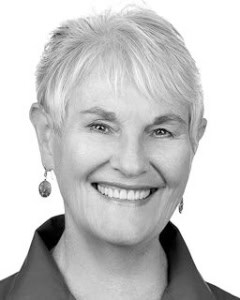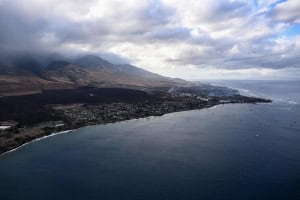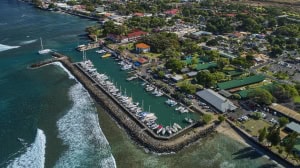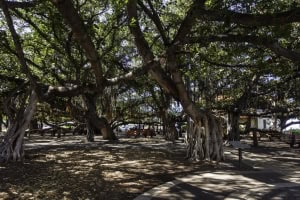Mourning Lahaina- an Interview with Jill Engledow
By joni Johnson
“My friend lost her husband and her house in one night. How do you deal with that? Another friend helping to clear out dead wood, stepped into a hot spot and was taken to the hospital for multiple burn recovery. She was in Kula where another fire was burning at the same time.”

Jill Engledow
RVM resident, Jill Engledow told me this during a conversation we had in early September. This article is about Lahaina and the devastation created by the surprise fires of August 8, 2023. Jill has written four books about Hawaii. Among them is one called The Story of Lahaina. She knows Lahaina intimately. She was a reporter for the Maui News largely covering Lahaina and the surrounding areas in the 80’s. Then she turned to writing historical reports and worked with the Lahaina Restoration Foundation to do museum displays. All of Jill’s books are in the RVM Library.

Jill’s book on Lahaina
There is no way to keep up with all of the changes that have happened since the fire because stories are changing by the minute. However, Jill’s intimate experience with Lahaina over so many years can give us a special insight into what was and what might be. Two weeks have passed since the interview and one month will have passed by the time this article goes to print. So I will fill in some information not known at the time that we spoke.
The entire island is grieving. On September 1, all of the islands held vigils for all that was lost. They were all held three times, morning, noon and sunset, and, depending on the location, they consisted of hula and other musical tributes as well as interfaith ceremonies. But that was only one day. Jill says there is an enormous pall all over the island. People are hugging and sharing their loss. Therapists are offering their services. And activities for children to help promote recovery are taking place.

Lahaina aerial photo after fire

Lahaina Harbor-Before

Lahaina Harbor- After
From Jill’s perspective, because of new laws and regulations developed after Lahaina was built, the old town can never be rebuilt the way it was. The town is largely a town with narrow streets and no sidewalks. A lot of the Front Street buildings were built on the shore-line, even extending out into the ocean on stilts. With sea-rise happening, there are new setback regulations. Jill thinks that one alternative would be to build uphill where there is plenty of room. On one side of the road uphill, there were a number of structures and other houses. Some of them escaped serious damage in the fire. Luckily, the Lahainaluna High School, which had originally been built in the early 1800’s as a seminary for Hawaiian men and finally a public high school, is still standing but closed. Another RVM connection here is that Arnold Lum’s father was the farm manager and boarding supervisor at Lahainaluna from 1926 to 1944.
However, Hale Mahaolu Eono senior-living complex, burned down. People were able to live there in a one bedroom palm-fringed apartment overlooking the Pacific. Because the housing was subsidized, the cost could be only $150 per month. They held group barbecues and monthly birthday celebrations much like the Manor. They felt like they had found stability on an island where many elders — known in Hawaiian as “kupuna” — had been priced out after a lifetime of raising families and serving tourists. Now, the housing complex is rubble. So some buildings will need to be rebuilt, while others remain standing just like they did in the Almeda Fire. However, the other side of the street is largely open and available. There is a very strong feeling in Hawaii that the residents of Lahaina should decide how their town should be rebuilt, and Jill agrees with this. For the latest news on rebuilding check out this article which talks about the latest in setting up community meetings:

Banyan Tree is coming back to life

Banyan Tree- Before
Another important issue is water. Lahaina was built on wetlands with streams and ponds. However, starting in the 1800’s, the pineapple plantations began changing the water flow, and it has never returned to its former glory. Much of the water in Lahaina comes from wells. A water rights activist has said that those in the Lahaina area can safely draw 500 millions of gallons a day. This is what is currently being drawn. Restoring the surface water would replenish the aquifer.
How Lahaina will rebuild itself is still unknown. Most people still can’t get to their houses because of the toxic waste and unsafe buildings. From one article I read, they have managed to clean up 15% so far.
A look at how other communities have dealt with similar calamities is instructive. In Hilo, after a tsunami, the state took over the whole lower section and made it into a big memorial park. Crescent City got their city back in about two years after the Tsunami of 1964, which started as a 9.2 earthquake in Alaska. Twenty-nine city blocks were devastated.
After the Loma Prieta earthquake in 1989, Santa Cruz managed to rebuild much of its downtown area in four years. In 2011, 22 years after the earthquake, Nikki MacDonald wrote, “The first impulse after a disaster is to put everything back the way it was. You can’t do that. The first thing that has to happen is that people have to get that. Not just intellectually, but emotionally.” A school gym was set up with tables of eight for a three-day design symposium. Santa Cruz locals discussed, drew, and then presented their central city concept. One group wanted a little Venice, with canals instead of streets.
“That [the symposium] was a brilliant idea,” says Pacific Cookie Company owner Larry Pearson, who lost his Pacific Ave flagship store and doughmaking facility in the quake. “It allowed everybody an outlet for all these feelings they had. People were just pent up with very strong opinions, because people cared so much. People got to see their ideas actually represented, and to see people’s reactions to them.”
Currently, Summer Sylva, the senior advisor for Native Hawaiian Affairs in the U.S. Department of the Interior, has been assigned to FEMA’s Cultural Protocol Task Force to ensure that the federal response to the devastation is sensitive to the needs of the community.
Sylva, who is kanaka maoli, a Native Hawaiian with roots in Lahaina, said the destruction has highlighted the longstanding tensions between Hawaii residents and the federal government, especially when it comes to the land and how it’s treated, she told ABC News.
So now there are many interests and forces trying to determine the fate of Lahaina. It all will take time to play out. Meanwhile, shortly after Jill and I spoke, she left for Maui hoping to help in any way possible. “It will always be home to me, no matter where I live.”



Leave a Reply
Want to join the discussion?Feel free to contribute!